

Hosting multiple websites with Apache2. Posted by Steve on Thu 6 Jul 2006 at 22:03 One of the most common Apache2 questions I've seen on Debian mailing lists is from users who wonder how to host multiple websites with a single server.

This is very straightforward, especially with the additional tools the Debian package provides. Command Line Tools Based on Symfony Console (Doctrine, Laravel) in PhpStorm. Ever since PhpStorm 2, we have had support for working with the Symfony console right from within the IDE.
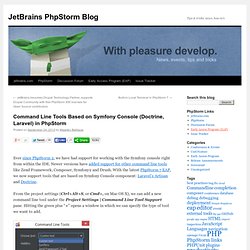
Newer versions have added support for other command line tools like Zend Framework, Composer, Symfony2 and Drush. With the latest PhpStorm 7 EAP, we now support tools that are based on Symfony Console component: Laravel’s Artisan and Doctrine. From the project settings (Ctrl+Alt+S, or Cmd+, on Mac OS X), we can add a new command line tool under the Project Settings | Command Line Tool Support pane. Setting up your first Laravel 4 Model. Model-View-Controller (MVC) is a very common design pattern in modern web applications.
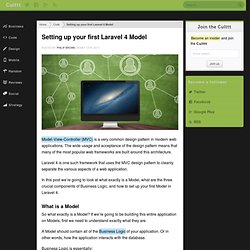
The wide usage and acceptance of the design pattern means that many of the most popular web frameworks are built around this architecture. Laravel 4 is one such framework that uses the MVC design pattern to cleanly separate the various aspects of a web application. Comment formatting. This page describes some of the formatting options while commenting on Less Wrong.

For a complete description, see the official Markdown syntax page, but note that Less Wrong comments use a subset of Markdown, with the main difference being that you can't use inline HTML. Here are two sandboxes you can use to experiment. (For the Wiki formatting rules, see Help:Formatting at MediaWiki and Help:Style_Guide#Formatting.) Basic *italics* gives italics**bold** gives bold[Less Wrong]( gives Less Wrong. Markdown Cheatsheet · adam-p/markdown-here Wiki. The OAuth 1.0 Guide. OAuth Core 1.0 (also known as RFC 5849), the community-based specification published on December 4th, 2007, revised June 24th, 2009, and finalized in April 2010 is one of the fastest growing Open Web specifications.
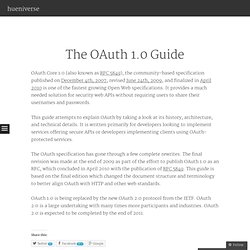
It provides a much needed solution for security web APIs without requiring users to share their usernames and passwords. This guide attempts to explain OAuth by taking a look at its history, architecture, and technical details. It is written primarily for developers looking to implement services offering secure APIs or developers implementing clients using OAuth-protected services. Working With Gumby Claymate and Laravel. Building a Responsive Website with the Gumby Framework. Gumby Responsive CSS Grid Toggles and Switches - DigitalSurgeons.com. So for those of you that don’t know, the team here at Digital Surgeons created a responsive CSS grid framework last year called Gumby Framework.
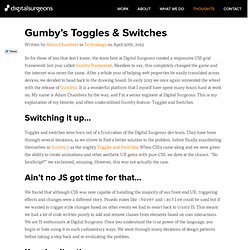
Needless to say, this completely changed the game and the internet was never the same. After a whole year of helping web properties be easily translated across devices, we decided to head back to the drawing board. Markdown Cheatsheet · adam-p/markdown-here Wiki. Using CORS. Introduction.

OAuth2 with AngularJS to access Twitter. Currently my latest activities tend to be more front-end centric.
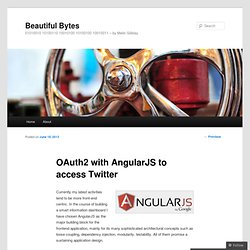
In the course of building a smart information dashboard I have chosen AngularJS as the major building block for the frontend application, mainly for its many sophisticated architectural concepts such as loose coupling, dependency injection, modularity, testability. All of them promise a sustaining application design. A significant functional element of this dashboard is among others a classic Twitter integration. In the first place this may sound as a relatively trivial task to accomplish given the fact, that Twitter’s REST API offers numerous services and documented examples in the internet are well-spread. The initial solution would integrate with the search API before a more complex solution via the streaming API is developed in a later stage of development.
We are done – more or less. The above solution did work quite flawlessly…since yesterday. In the first place the current REST access needs to change to the new API. Understanding OAuth - Tweeting from Scratch, Part 1. Laravel 4: Develop Packages Using The Workbench – Jason Lewis. In the early days of Laravel we were blessed with modules.

Modules allowed us to separate parts of our applications into more manageable pieces. This meant that modules could contain their own controllers, routes, libraries, configuration, composers, filters, etc. When Laravel 3 was released modules were revamped and renamed to bundles. A Laravel specific bundle repository was setup and developers could publish their bundles so that others could install them with Artisan. It was a great way to easily drop code in to an existing application. Interactive Data Visualization for the Web. Copyright © 2013 Scott Murray Printed in the United States of America.
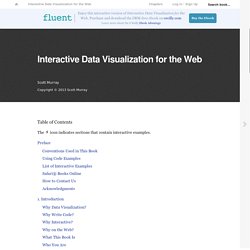
Css animations · tutorials. By Mike Sierra Summary CSS animations allow you to build complex animated sequences. Like transitions, they manipulate the CSS properties that control how interface elements appear. Unlike transitions, they are not tied to shifts between style sheets that distinguish interface states. Keyframe animations can execute freely, and offer the best way to build complex effects into an interface. To get the most from this tutorial, you should already be familiar with CSS transitions. These key points serve as reference: Laravel 4 Real Time Chat. Laravel 4 is a huge step forward for the PHP community.